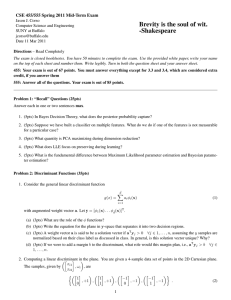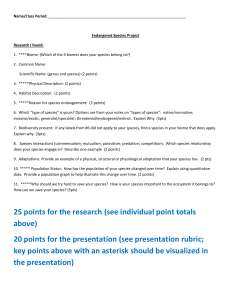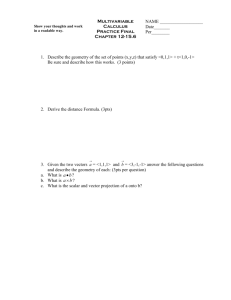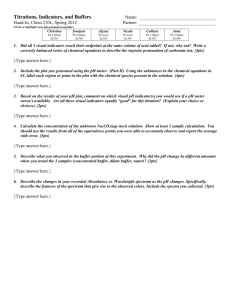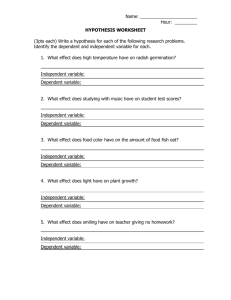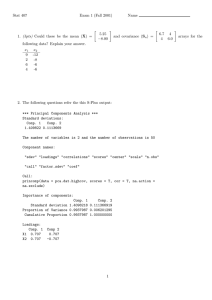CSE 555 Spring 2010 Mid-Term Exam
advertisement
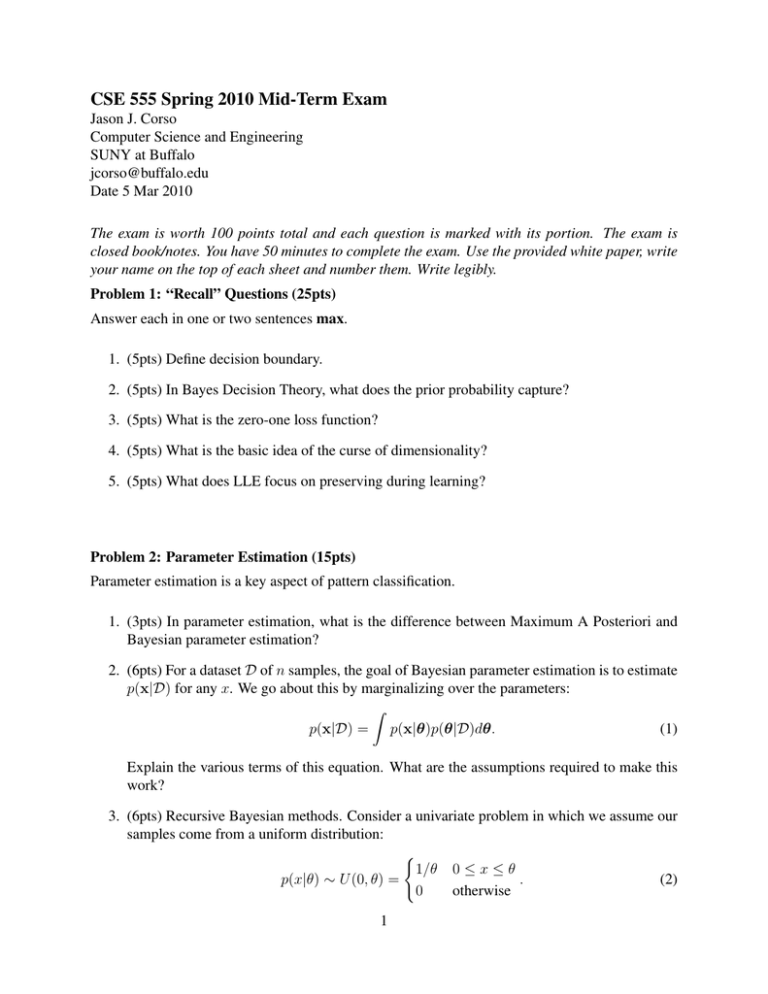
CSE 555 Spring 2010 Mid-Term Exam
Jason J. Corso
Computer Science and Engineering
SUNY at Buffalo
jcorso@buffalo.edu
Date 5 Mar 2010
The exam is worth 100 points total and each question is marked with its portion. The exam is
closed book/notes. You have 50 minutes to complete the exam. Use the provided white paper, write
your name on the top of each sheet and number them. Write legibly.
Problem 1: “Recall” Questions (25pts)
Answer each in one or two sentences max.
1. (5pts) Define decision boundary.
2. (5pts) In Bayes Decision Theory, what does the prior probability capture?
3. (5pts) What is the zero-one loss function?
4. (5pts) What is the basic idea of the curse of dimensionality?
5. (5pts) What does LLE focus on preserving during learning?
Problem 2: Parameter Estimation (15pts)
Parameter estimation is a key aspect of pattern classification.
1. (3pts) In parameter estimation, what is the difference between Maximum A Posteriori and
Bayesian parameter estimation?
2. (6pts) For a dataset D of n samples, the goal of Bayesian parameter estimation is to estimate
p(x|D) for any x. We go about this by marginalizing over the parameters:
Z
p(x|D) = p(x|θ)p(θ|D)dθ.
(1)
Explain the various terms of this equation. What are the assumptions required to make this
work?
3. (6pts) Recursive Bayesian methods. Consider a univariate problem in which we assume our
samples come from a uniform distribution:
(
1/θ 0 ≤ x ≤ θ
p(x|θ) ∼ U (0, θ) =
.
(2)
0
otherwise
1
Initially, assume it is a non-informative prior bounded at the top at 10, i.e., 0 < θ ≤ 10. Use
recursive Bayes to estimate θ for the following two samples of data D = {5, 2}. Give the
analytical form after each iteration of the recursion.
Problem 3: Discriminant Functions (40pts)
This problem is about discriminant functions.
1. Consider the general linear discriminant function
g(x) =
dˆ
X
ai φi (x)
(3)
i=1
with augmented weight vector a. Let y = [φ1 (x) . . . φdˆ(x)]T .
(a) (3pts) What are the role of the φ functions?
(b) (3pts) Write the equation for the plane in y-space that separates it into two decision
regions.
(c) (3pts) A weight vector a is said to be a solution vector if aT yj > 0 ∀j ∈ 1, . . . , n. In
general, is this solution vector unique? Why?
2. Consider the relaxation criterion function, let b be a margin,
2
1 X −aT y − b
Jr (a) =
2 y∈Y
kyk2
(4)
(a) (3pts) Compare this relaxation criterion function to the perceptron criterion function.
(b) (4pts) For a single-sample relaxation learning procedure, what is the update rule?
(c) (4pts) What is the geometrical interpretation of the update rule? Draw a figure to help
explain.
3. (20pts) Relating the Minimum-Squared Error procedure for training generalized linear discriminants to the Fisher linear discriminant. Recall the MSE procedure for estimating a
discriminant. In matrix Y let each row be a data sample, and let b be a vector of margin
values for each point. The MSE procedure turns the inequalities into equalities:
Ya=b
(5)
Ultimately, the solution we seek minimizes the sum-of-squared error criterion over all of the
samples:
Js (a) =
n
X
i=1
2
(aT yi − bi )2 .
(6)
Taking the derivative and equating it to 0 gives us the necessary conditions:
Y T Y a = Y T b.
(7)
a = (Y T Y )−1 Y T b.
(8)
The pseudoinverse is how we solve it.
Consider the following specific augmentation and selection of the margin vector. Assume
(1) the augmentation is to simply add a constant 1 to the top of each sample vector, (2) we
normalize the class ω2 samples by multiplying by -1, and (3) the first n1 samples are labeled
ω1 and the second n2 samples are labeled ω2 . X1 is the matrix of class 1 samples x with each
row a sample, and X2 is the matrix for class 2 samples. 1i is a column vetor of ni ones.
11 X1
Y =
(9)
12 X2
Let b be set as the following.
n
b=
1
n1 1
n
1
n2 2
(10)
Show that for this choice of the margin vector, the MSE solution is equivalent, up to a scale
factor, to the Fisher linear discriminant.
Problem 4: General Pattern Recognition (20pts)
For the two-class problem (cross and solid) in the figure below, describe how you might design a
classifier based on ideas we’ve covered.
y2
y1
3
